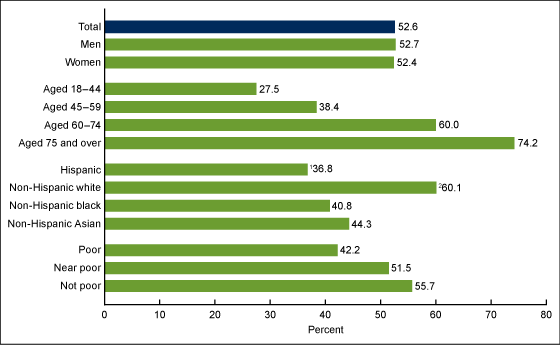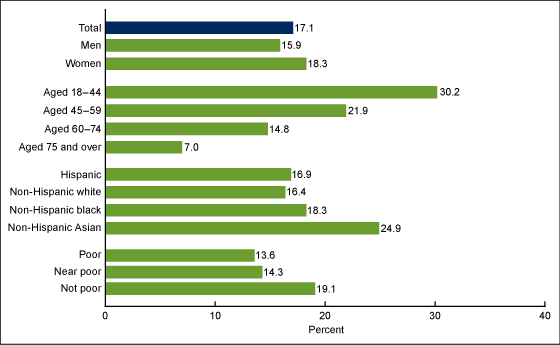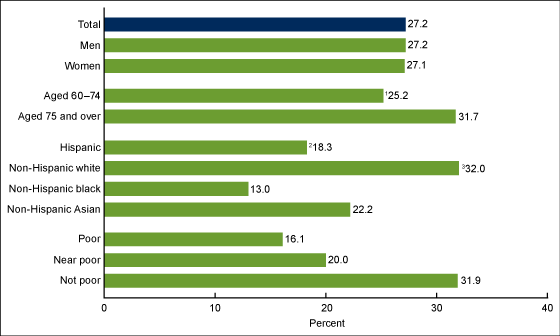Vaccination Coverage Among Adults With Diagnosed Diabetes: United States, 2015
On This Page
- Key findings
- The percentage of adults with diagnosed diabetes who had an influenza vaccine in the past year was lowest among those aged 18–44 and among adults who were non-Hispanic black, Hispanic, or poor.
- The percentage of adults with diagnosed diabetes who ever had a pneumococcal vaccine was highest among those aged 75 and over and among adults who were non-Hispanic white, near poor, or not poor.
- Adults with diagnosed diabetes who were most likely to have had the 3-dose vaccination schedule for hepatitis B were those aged 18–44 and adults who were not poor.
- Among adults aged 60 and over with diagnosed diabetes, the groups most likely to have been vaccinated for shingles were those aged 75 and over, non-Hispanic white adults, and not-poor adults.
- Summary
- Definitions
- Data source and methods
- About the authors
- References
- Suggested citation
NCHS Data Brief No. 265, December 2016
PDF Version (339 KB)
Maria A. Villarroel, Ph.D., and Anjel Vahratian, Ph.D.
Key findings
Data from the National Health Interview Survey
- Among adults aged 18 and over with diagnosed diabetes, 61.6% had an influenza vaccine in the past year.
- A total of 52.6% of adults with diagnosed diabetes had a pneumococcal vaccine and 17.1% had the 3-dose vaccination schedule for hepatitis B at some point in the past.
- Among adults aged 60 and over with diagnosed diabetes, 27.2% had ever had a shingles vaccine.
- Among those with diagnosed diabetes, the vaccination coverage for influenza, pneumococcal, and shingles was lowest among poor adults, increased with age, and varied by race and ethnicity.
- Hepatitis B vaccination coverage was lowest among poor adults, and it decreased with age.
Persons with diabetes are at an increased risk for complications from vaccine-preventable infections (1–3). Several vaccines are recommended for adults with diabetes, including annual vaccination for influenza and at least a one-time dose of pneumococcal vaccine, regardless of age; a shingles vaccine starting at age 60; and a hepatitis B vaccine soon after diabetes diagnosis among those aged 19–59, and based on clinical discretion thereafter (4). This report describes the receipt of select vaccinations among adults with diagnosed diabetes by sex, age, race and ethnicity, and poverty status.
Keywords: prevention, adult immunization, medical care, National Health Interview Survey
The percentage of adults with diagnosed diabetes who had an influenza vaccine in the past year was lowest among those aged 18–44 and among adults who were non-Hispanic black, Hispanic, or poor.
- Nearly two-thirds (61.6%) of adults aged 18 and over with diagnosed diabetes had an influenza vaccine in the past year (Figure 1).
- The percentage of adults with diagnosed diabetes who had an influenza vaccine in the past year increased with age. A total of 41.4% of those aged 18–44, 51.0% of those aged 45–59, 69.1% of those aged 60–74, and 74.5% of those aged 75 and over were vaccinated for influenza in the past year.
- Among those with diagnosed diabetes, non-Hispanic Asian (71.1%) and non-Hispanic white (65.3%) adults were more likely to have had an influenza vaccine in the past year compared with Hispanic (53.9%) and non-Hispanic black (51.1%) adults.
- Influenza vaccination increased with income status among those with diagnosed diabetes. A total of 50.9% of poor adults with diagnosed diabetes had an influenza vaccine in the past year compared with 57.8% of near-poor and 65.9% of not-poor adults.
Figure 1. Percentage of adults aged 18 and over with diagnosed diabetes who had an influenza vaccine in the past year, by select demographics: United States, 2015
1Significantly different from non-Hispanic white and non-Hispanic Asian (p < 0.05).
2Significantly different from non-Hispanic black (p < 0.05).
3Significantly different from non-Hispanic Asian (p < 0.05).
NOTES: There is a significant linear trend by age group and by income status (p < 0.05). Access data table for Figure 1.
SOURCE: NCHS, National Health Interview Survey, 2015, Family Core and Sample Adult components.
The percentage of adults with diagnosed diabetes who ever had a pneumococcal vaccine was highest among those aged 75 and over and among adults who were non-Hispanic white, near poor, or not poor.
- Overall, 52.6% of adults aged 18 and over with diagnosed diabetes had a pneumococcal vaccine at some point in the past (Figure 2).
- The percentage of adults with diagnosed diabetes who ever had a pneumococcal vaccine increased with age. A total of 27.5% of those aged 18–44, 38.4% of those aged 45–59, 60.0% of those aged 60–74, and 74.2% of those aged 75 and over had a pneumococcal vaccine at some point in the past.
- Sixty percent (60.1%) of non-Hispanic white adults with diagnosed diabetes had a pneumococcal vaccine at some point in the past compared with 36.8% of Hispanic, 40.8% of non-Hispanic black, and 44.3% of non-Hispanic Asian adults with diagnosed diabetes.
- The percentage of adults with diagnosed diabetes who ever had a pneumococcal vaccine increased with income status. A total of 42.2% of those who were poor, 51.5% of those who were near poor, and 55.7% of those who were not poor had ever had a pneumococcal vaccine.
Figure 2. Percentage of adults aged 18 and over with diagnosed diabetes who ever had a pneumococcal vaccine, by select demographics: United States, 2015
1Significantly different from non-Hispanic white (p < 0.05).
2Significantly different from non-Hispanic black and non-Hispanic Asian (p < 0.05).
NOTES: There is a significant linear trend by age group and by income status (p < 0.05). Access data table for Figure 2.
SOURCE: NCHS, National Health Interview Survey, 2015, Family Core and Sample Adult components.
Adults with diagnosed diabetes who were most likely to have had the 3-dose vaccination schedule for hepatitis B were those aged 18–44 and adults who were not poor.
- Seventeen percent (17.1%) of adults with diagnosed diabetes had the 3-dose vaccination schedule for hepatitis B (Figure 3).
- Having had the 3-dose vaccination schedule for hepatitis B decreased with age among adults with diagnosed diabetes. A total of 30.2% of those aged 18–44 had the 3-dose vaccination schedule for hepatitis B compared with 21.9% of those aged 45–59, 14.8% of those aged 60–74, and 7.0% of those aged 75 and over.
- Having had the 3-dose vaccination schedule for hepatitis B increased with income status among adults with diagnosed diabetes. A total of 13.6% of poor, 14.3% of near-poor, and 19.1% of not-poor adults had the 3-dose vaccination schedule for hepatitis B at some point in the past.
Figure 3. Percentage of adults aged 18 and over with diagnosed diabetes who had the 3-dose vaccination schedule for hepatitis B, by select demographics: United States, 2015
NOTES: There is a significant linear trend by age group and by income status (p < 0.05). Access data table for Figure 3.
SOURCE: NCHS, National Health Interview Survey, 2015, Family Core and Sample Adult components.
Among adults aged 60 and over with diagnosed diabetes, the groups most likely to have been vaccinated for shingles were those aged 75 and over, non-Hispanic white adults, and not-poor adults.
- More than one-fourth of adults aged 60 and over with diagnosed diabetes (27.2%) ever had a shingles vaccine (Figure 4).
- Nearly one-third of adults aged 75 and over (31.7%) with diagnosed diabetes had a shingles vaccine compared with one-fourth of those aged 60–74 (25.2%).
- Among adults aged 60 and over with diagnosed diabetes, non-Hispanic white adults (32.0%) were 2.5 times as likely as non-Hispanic black adults (13.0%) and 1.7 times as likely as Hispanic adults (18.3%) to have had a shingles vaccine.
- The percentage of adults aged 60 and over with diagnosed diabetes who ever had a shingles vaccine increased with income status. A total of 16.1% of those who were poor, 20.0% of those who were near poor, and 31.9% of those who were not poor had ever had a shingles vaccine.
Figure 4. Percentage of adults aged 60 and over with diagnosed diabetes who ever had a shingles vaccine, by select demographics: United States, 2015
1Significantly different from those aged 75 and over (p < 0.05).
2Significantly different from non-Hispanic white (p < 0.05).
3Significantly different from non-Hispanic black (p < 0.05).
NOTES: There is a significant linear trend by income status (p < 0.05). Access data table for Figure 4.
SOURCE: NCHS, National Health Interview Survey, 2015, Family Core and Sample Adult components.
Summary
One in 10 adults aged 18 and over has been diagnosed with diabetes (5). Among adults aged 18 and over with diagnosed diabetes, influenza vaccination (61.6%) was more prevalent than pneumococcal (52.6%) and hepatitis B (17.1%) vaccination. Fewer than 3 in 10 (27.2%) adults aged 60 and over with diagnosed diabetes had been vaccinated for shingles.
Vaccination varied by age. Vaccination for influenza in the past year and pneumococcal disease at some point in the past increased with age among adults with diagnosed diabetes. Similarly, those aged 75 and over were more likely than those aged 60–74 to have been vaccinated for shingles. Although hepatitis B vaccination was infrequent among those with diagnosed diabetes, those aged 18–44 were most likely to be vaccinated, followed by those aged 45–59, then those aged 60 and over.
Vaccination varied by race and ethnicity. Non-Hispanic white adults were more likely than non-Hispanic black and Hispanic adults to have been vaccinated for influenza in the past year and to have ever been vaccinated for pneumococcal disease and shingles. Non-Hispanic Asian adults were more likely than non-Hispanic black and Hispanic adults to have been vaccinated for influenza, but these groups did not differ from one another on pneumococcal and shingles vaccination. Racial and ethnic differences in adult vaccination have been previously observed and may be attributed to multiple social barriers (6).
Vaccination coverage varied by income status. Adults with diagnosed diabetes who were not living in poverty were the most likely to have been vaccinated for influenza, pneumococcal disease, hepatitis B, and shingles, despite a higher prevalence of diagnosed diabetes among poor and near-poor adults (7). Vaccination coverage for influenza, pneumococcal disease, hepatitis B, and shingles was equivalent between women and men with diagnosed diabetes.
Vaccination coverage among U.S. adults has been previously reported (8). Vaccination coverage among U.S. adults overall is lower for influenza and pneumococcal disease, higher for hepatitis B, and similar for shingles compared with the vaccination coverage found among adults with diagnosed diabetes.
Definitions
Diagnosed diabetes: Based on a positive response to the survey question, “Have you ever been told by a doctor or health professional that you have diabetes or sugar diabetes?” Women were asked to exclude diagnoses received only during pregnancy.
Ethnicity and race: Hispanic or Latino origin and race are two separate categories. Hispanic or Latino origin includes persons of Mexican, Puerto Rican, Dominican, Cuban, Central and South American, Spanish, or other not specified Latin America, Hispanic, or Latino origin. More than one race may be reported for a person. Persons of Hispanic or Latino origin may be of any race or combination of races. Non-Hispanic white, non-Hispanic black, and non-Hispanic Asian refers to persons who indicated this single race group and are not of Hispanic or Latino origin.
Hepatitis B vaccine: Based on a positive response to the survey question, “Have you ever received the hepatitis B vaccine?” and a response of at least 3 doses when asked the follow-up question, “Did you receive at least 3 doses of the hepatitis B vaccine, or less than 3 doses?”
Income status: “Poor” adults are defined as having family incomes below the federal poverty level (FPL). “Near-poor” adults are defined as having family incomes that are 100% to less than 200% of the FPL. “Not-poor” adults are defined as having family incomes that are 200% or greater than the FPL. Income is based on reported or imputed family income (9). Poverty levels are updated annually by the U.S. Census Bureau to reflect changes in the Consumer Price Index. For further information, visit the U.S. Census Bureau website.
Influenza vaccine: Based on a positive response to the survey question, “During the past 12 months, have you had a flu shot? A flu shot is usually given in the fall and protects against influenza for the flu season.” Sample adults were read the following statements after the question if necessary, “A flu shot is injected in the arm. Do not include an influenza vaccine sprayed in the nose” to exclude the nasal flu vaccine.
Pneumococcal vaccine: Based on a positive response to the survey question, “Have you ever had a pneumonia shot? This shot is usually given only once or twice in a person’s lifetime and is different from the flu shot. It is also called the pneumococcal vaccine.”
Shingles vaccine: Based on a positive response to the survey question, “Have you ever had the zoster or shingles vaccine, also called Zostavax®?” This question was preceded with the introduction, “Shingles is an outbreak of a rash or blisters on the skin that may be associated with severe pain. The pain is generally on one side of the body or face. Shingles is caused by the chicken pox virus. A vaccine for shingles has been available since May 2006.”
Data source and methods
Data from the 2015 National Health Interview Survey (NHIS) were used for this analysis. NHIS is a multipurpose health survey conducted continuously throughout the year by the National Center for Health Statistics (NCHS). Interviews are conducted in person in respondents’ homes, but follow-ups to complete interviews may be conducted over the telephone. The survey consists of (a) a Family Core component, which collects information on all family members; (b) a Sample Adult component, which collects information from one randomly selected adult per family; and (c) a Sample Child component, which collects information about one randomly selected child per family. Data for this analysis come from the Family Core and Sample Adult components of NHIS. For further information about NHIS, including the questionnaire, visit the NHIS website.
All analyses used weights to produce national estimates. Estimates on adult immunizations in this report are nationally representative of the civilian noninstitutionalized adult population aged 18 and over living in households across the United States. The sample design is described in more detail elsewhere (10). Point estimates and their estimated variances were calculated using SUDAAN software (11) to account for the complex sample design of NHIS. The Taylor series linearization method was used for variance estimation. Linear trend tests of the estimated proportions across the levels of age and income groups were tested in SUDAAN via PROC DESCRIPT using the POLY option. Differences between percentages were evaluated using two-sided significance tests at the 0.05 level.
About the authors
Maria A. Villarroel and Anjel Vahratian are with the National Center for Health Statistics, Division of Health Interview Statistics.
References
- Smith SA, Poland GA. Use of influenza and pneumococcal vaccines in people with diabetes. Diabetes Care 23(1):95–108. 2000.
- Centers for Disease Control and Prevention. Use of hepatitis B vaccination for adults with diabetes mellitus: Recommendations of the Advisory Committee on Immunization Practices (ACIP). MMWR Morb Mortal Wkly Rep 60(50):1709–11. 2011.
- Suaya JA, Chen SY, Li Q, Burstin SJ, Levin MJ. Incidence of herpes zoster and persistent post-zoster pain in adults with or without diabetes in the United States. Open Forum Infect Dis 1(2):ofu049. 2014.
- Kim DK, Bridges CB, Harriman KH. Advisory committee on immunization practices recommended immunization schedule for adults aged 19 years or older—United States, 2016. MMWR Morb Mortal Wkly Rep 65:88–90. 2016.
- Ward BW, Clarke TC, Schiller JS. Early release of selected estimates based on data from the January–June 2016 National Health Interview Survey. National Center for Health Statistics. 2016.
- National Foundation for Infectious Diseases. A report on reaching underserved ethnic and minority populations to improve adolescent and adult immunization rates. Bethesda, Maryland. 2002.
- Blackwell DL, Villarroel MA. Tables of summary health statistics for U.S. adults: National Health Interview Survey, 2015. National Center for Health Statistics. 2015.
- Williams WW, Lu PJ, O’Halloran A, Kim DK, Grohskopf LA, Pilishvili T, et al. Surveillance of vaccination coverage among adult populations—United States, 2014. MMWR Surveill Summ 65(1):1–36. 2016.
- Multiple imputation of family income and personal earnings in the National Health Interview Survey: Methods and examples. National Center for Health Statistics. 2016.
- Parsons VL, Moriarity CL, Jonas K, et al. Design and estimation for the National Health Interview Survey, 2006–2015. National Center for Health Statistics. Vital Health Stat 2(165). 2014.
- RTI International. SUDAAN (Release 11.0.0) [computer software]. 2012.
Suggested citation
Villarroel MA, Vahratian A. Vaccination coverage among adults with diagnosed diabetes: United States, 2015. NCHS data brief, no. 265. Hyattsville, MD: National Center for Health Statistics. 2016.
Copyright information
All material appearing in this report is in the public domain and may be reproduced or copied without permission; citation as to source, however, is appreciated.
National Center for Health Statistics
Charles J. Rothwell, M.S., M.B.A., Director
Jennifer H. Madans, Ph.D., Associate Director for Science
Division of Health Interview Statistics
Marcie L. Cynamon, Director
Stephen J. Blumberg, Ph.D., Associate Director for Science
- Page last reviewed: December 6, 2016
- Page last updated: December 6, 2016
- Content source:


 ShareCompartir
ShareCompartir



